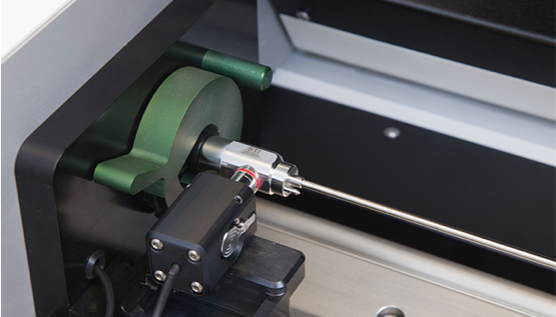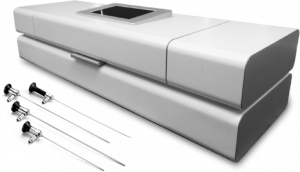Why would I do an automated rigid endoscope test?
Well, a human can never judge if, for instance, a fiber package is 20-25% defective by observation only.
In addition, a gradual decline in quality cannot be observed by humans.
However, that's what the manufacturer expects of you. A superhuman ability to determine fit-for-use.
Our IFU says nothing about how to check endoscopes, so why choose ScopeControl?
Isn't that strange?
(Supra)national regulations mandate that User Manuals need to be specific about how you can determine if a rigid endoscope is still fit to be cleaned for another re-use cycle, rather than provide non-specific disclaimers, notes and warnings that may be subject to a degree of interpretation.
OEMs should comply to ISO 17664-1. As far as we know, no endoscope manufacturer has ever specified clear re-use related quality failure parameters. However, hospitals need appropriate procedures and criteria to be able to determine if re-usable devices are still ok after every re-use. Otherwise you can't be certain that the device may be used on the next patient.
Our IFU states some quality references that we regularly check. Why use ScopeControl?
References in the instructions for use (IFU) to inspection procedures that are not suitable for adequately confirming that re-use is possible or not, puts hospitals at risk because they cannot confirm if the device is safe to be re-used.
As a result, patient safety is potentially jeopardized and claims can be directed to manufacturers, hospitals and repair facilities if patients are harmed.
Because it is the obligation of the hospital to only use safe and compliant devices on patients, it is incumbent on the hospital to monitor quality, the decline of quality, when a device needs to be replaced or repaired and to validate a quality process based on a reproducible process based on empirical data.
With ScopeControl, endoscopes are tested under the same conditions and preset specifications every time.
We test manually. We have a standardised process. Why work with this?
Your process may be standardized, but it always varies from one colleague to another. And when time passes, it becomes even more difficult to keep your colleagues attentive to doing things the same way.
Also: humans can't see gradual change.
If you're already realizing that this should be easier, faster and not an extra burden on your colleagues, ScopeControl makes sure everyone works the same.
We have a company that comes in every halfyear to check our endoscopes. They call it an audit. That should be enough, right?
Just because you outsource the job, doesn't mean that you've outsourced the risk and responsibility, even if your supplier says that you can. Have you validated how they check? Is it in line with the IFUs? Are they OEM approved? Do you do regular audits on them?
Our repair company and/or external CSSD is responsible for the quality of our endoscopes.
Why do we need ScopeControl?
Just because you outsource the job, doesn't mean that you've outsourced the risk and responsibility.
The manufacturer will generally specify that instruments must be serviced and repaired only by persons authorized by them. Not many companies are.
When devices have been repaired or serviced by unauthorized persons the manufacturer can no longer guarantee quality and will not provide continued warranty for the device. Did you check this lately?
How do you verify that optics returns with adequate quality? Can you prove that?
With ScopeControl you can!
We have never had any problem with our optics, why should I spend my money on you?
Your manufacturer is only liable for failure or deterioration of safe operation, operational safety and performance if you have used your rigid endoscopes in accordance with the operating instructions at all times.
However, just following these procedures does not necessarily prove that you performed everything in accordance with these specifications, because you can't show proof that you did.
With ScopeControl, you can prove that you have worked compliantly and that the endscope is in conformity with manufacturer provided specifications.
This is a nice-to-have, but not a must-have, right?
If your manufacturer provides specific information on when a device should no longer be used, you can't establish when a device should no longer be re-used in order to safeguard patient safety.
This exposes you to potentially large risks: a hospital has a legal obligation to have a procedure in place that results in compliant devices.
Working with ScopeControl in combination with endoscopemanager.com allows for more precise testing control and proof of re-use cycles, making achieving compliance easier.
We already have an optics tester from our manufacturer. Why buy ScopeControl?
Because it takes forever to set up, it's a pain to use and it doesn't register anything.
Furthermore, as we say in Dutch, the butcher checks the quality of his own meat.
It's made by people that make medical devices, not testing equipment.
How much money does this thing actually save, if any?
ScopeControl has been sold in over 100 hospitals across the world. On average, a regional general hospital saves € 100.000,-, because they increase quality and foresee things better. It also drastically improves downtimes in the OR.
Here are customer testimonials from:
We can also provide you with a calculation sheet. Just send in your contact details
here
I love your website, but do you have a brochure?
Well, thanks! We try really hard to be informative and appealing.
ScopeControl looks very complicated. How much training do we need?
ScopeControl needs very little training. A morning or afternoon is enough.
There are only 5 simple steps to prepare for a test:
- Beep in the QR code or insert in your brand and type.
- Attach the optic to the cradle.
- Press start and wait 3 minutes. You can do something else in the meantime.
- ScopeControl will give a simple pass/fail and provide additional quality information on screen.
- ScopeControl automatically uploads all data to endoscopemanager.com
- Go grab a coffee. Well done!
Does ScopeControl need a lot of maintenance?
Updates are done via the internet, if you have it connected and if you have a software SLA.
A yearly check-up can be done on-site. For the rest, oil the slider regularly. If you don't, ScopeControl will start squeeling. Keep it clean. That's about it.
How long does a test take?
Max. 3 minutes.
Can we rent ScopeControl?
Yes, you can either buy or rent. Actually, renting might be your cheaper option.



